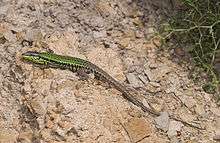Skyros wall lizard
The Skyros wall lizard (Podarcis gaigeae) is a species of lizards in the family Lacertidae. The species is endemic to the islands of Skyros and Piperi, Greece.
| Skyros wall lizard | |
|---|---|
 | |
| Scientific classification | |
| Kingdom: | Animalia |
| Phylum: | Chordata |
| Class: | Reptilia |
| Order: | Squamata |
| Family: | Lacertidae |
| Genus: | Podarcis |
| Species: | P. gaigeae |
| Binomial name | |
| Podarcis gaigeae (F. Werner, 1930) | |
| Synonyms | |
| |
Subspecies
Two subspecies are recognized. The nominotypical subspecies, Podarcis gaigeae gaigeae, is found on Skyros and associated islets, and the other subspecies, Podarcis gaigeae weigandi, is found on the island of Piperi.
Gigantism and polymorphy
The Skyros wall lizard exhibits island gigantism on small islets surrounding Skyros.[3] The Skyros wall lizard also exhibits a throat color polymorphy with six different throat color morphs that are expressed in both females and males.[4]
Etymology
The specific name, gaigeae, is in honor of American herpetologist Helen Beulah Thompson Gaige.[5]
Description
The Skyros wall lizard reaches a snout-to-vent length (SVL) of about 8.5 cm (3.3 in). It has a deep head and a tail approximately twice the length of the body. The colouring is rather variable, usually being green, olive-green, or brownish, with a dark vertebral band and dorso-lateral stripes. The mottled flanks often have a single blue spot above the shoulder. The underparts are white, often with dark spots on the throat, the lizards on each island having characteristic markings.[6]
Distribution
The Skyros wall lizard occurs only on Skyros and on Piperi Island in the Sporades archipelago in the northern Aegean Sea. It is the only small lizard occurring on these islands.
Habitat
The natural habitats of Podarcis gaigeae are Mediterranean-type shrubby vegetation, rocky areas, and rocky shores.[1]
Conservation status
The Skyros wall lizard has a total area of occupancy of less than 20 square kilometres (7.7 sq mi) but is common within that range. Although the population trend is unknown, no specific threats are apparent apart from the risks posed by wildfire. However the introduction onto its island home of some predatory species could threaten its survival so the International Union for Conservation of Nature has assessed its conservation status as being "vulnerable".[1]
References
- Lymberakis P (2009). "Podarcis gaigeae ". IUCN Red List of Threatened Species. 2009: e.T61547A12513064. doi:10.2305/IUCN.UK.2009.RLTS.T61547A12513064.en.
- "Podarcis gaigeae ". The Reptile Database. www.reptile-database.org.
- Runemark A (2012). "Island biogeography and population divergence in the Skyros wall lizard". Doctoral thesis, Lund University, Lund, Sweden. http://www.lu.se/o.o.i.s?id=12588&postid=2518407
- Runemark A, Hansson B, Pafilis P, Valakos ED, Svensson EI (2010). "Island biology and morphological divergence of the Skyros wall lizard Podarcis gaigeae: a combined role for local selection and genetic drift on color morph frequency divergence?" BMC Evol. Biol. 10: 269. http://www.biomedcentral.com/1471-2148/10/269
- Beolens, Bo; Watkins, Michael; Grayson, Michael (2011). The Eponym Dictionary of Reptiles. Baltimore: Johns Hopkins University Press. xiii + 296 pp. ISBN 978-1-4214-0135-5. (Podarcis gaigeae, p. 96).
- Arnold, E. Nicholas; Ovenden, Denys W. (2002). Field Guide: Reptiles & Amphibians of Britain & Europe. London: Collins & Co. pp. 178–179. ISBN 9780002199643.
Further reading
- Cattaneo A (1998). "Gli Anfibi e i Rettili delle isole greche di Skyros, Skopelos e Alonissos (Sporadi settentrionali) ". Atti Soc. italiana Sci. nat. Mus. civ. Stor. nat. Milano 139 (2): 127-149. ("Podarcis gaigeae gaigeae ", new combination, p. 131). (in Italian).
- Werner F (1930). "Contribution to the Knowledge of the Reptiles and Amphibians of Greece, Especially the Aegean Islands". Occasional Papers Univ. Michigan Mus. Zool. (211): 1-46, including Plates I-VI. (Lacerta taurica gaigeae, new subspecies, pp. 9–10 + Plate I, figures 4-6; Plate II, figures 7-11).
